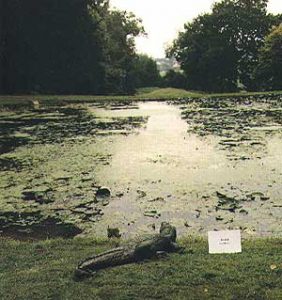TPE: Emblem, Wabi Sabi 2
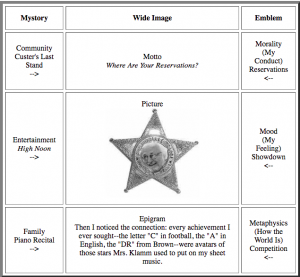 –Tenor (Themata): Catechism. The image on the left is the emblem Ulmer generated from his mystory, leading to design of his wide image in Noon Star. The formal rules from Koren’s relay generates theopraxesis by requiring that the answer to the catechism questions must be derived from one of the popcycle stories, each story used once only. The three capabilities are expressed in Wabi-Sabi by three M’s (resonating with the H’MMM disciplines): Metaphysics (Theoria); Morality (Praxis); Mood (Poiesis). Egents ask themselves:
–Tenor (Themata): Catechism. The image on the left is the emblem Ulmer generated from his mystory, leading to design of his wide image in Noon Star. The formal rules from Koren’s relay generates theopraxesis by requiring that the answer to the catechism questions must be derived from one of the popcycle stories, each story used once only. The three capabilities are expressed in Wabi-Sabi by three M’s (resonating with the H’MMM disciplines): Metaphysics (Theoria); Morality (Praxis); Mood (Poiesis). Egents ask themselves:
1) which of the popcycle stories, received as a fable (parable), expresses their understanding of how the world works, the character of reality. The Japanese tradition answers, “Things are either devolving toward, or evolving from, nothingness.” For Ulmer, the Family story of the botched piano recital, the red star (not gold or silver) on the sheet music, is a parable of a reality in which one is continuously judged in endless competitions. His epigram describes that condition.
2) Morality (Spiritual Values): which popcyle story is a fable of how one must act, given the character of reality? Wabi-Sabi proposes to get rid of what is unnecessary, ignore material hierarchy. For Ulmer, Custer’s foolish ambition serves as a negative example, a fable warning against Custer’s desire for glory. Ulmer’s motto expresses his lesson: Where are your Reservations?
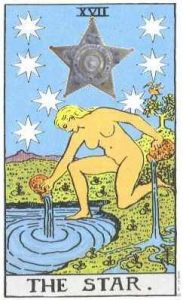 3) The third question is Mood: given the necessity to act in that way, in a world of that character, how do I feel? Wabi-Sabi advises acceptance of the inevitable and appreciation of the cosmic order. Ulmer found his state of mind expressed in High Noon as a fable of duty: despite his contempt for the hypocritical community, the sheriff fought the gang of killers, after which he threw away the tin star. This gesture of discarding the badge of status determined the tin star as the icon of the emblem. In practice it is best to decide which popcycle story supplies the picture, and which question of the catechism that story answers, and the rest of the emblem follows from there.
3) The third question is Mood: given the necessity to act in that way, in a world of that character, how do I feel? Wabi-Sabi advises acceptance of the inevitable and appreciation of the cosmic order. Ulmer found his state of mind expressed in High Noon as a fable of duty: despite his contempt for the hypocritical community, the sheriff fought the gang of killers, after which he threw away the tin star. This gesture of discarding the badge of status determined the tin star as the icon of the emblem. In practice it is best to decide which popcycle story supplies the picture, and which question of the catechism that story answers, and the rest of the emblem follows from there.
The wide image has no innate form, and is not confined to emblem poetics. It is inchoate, accessed intuitively, acquired during the early years of embodied visceral education. It may take many forms and manifest itself within the creative production of an egent. The heuretic frame of electrate pedagogy moves egents through the transition from a condition of privation, Steresis, impotence, potentiality of capability (Dunamis, Virtuality) into Energeia, Actualization, raising consciousness of their positioning and disposition relative to the archive of world culture recording in infinite variation the unfolding of the work of realization of life and death. Konsult is equipment for living (Kenneth Burke), thus, empowering in principle the egent with the resources of civilization available for a fatal encounter with disaster.

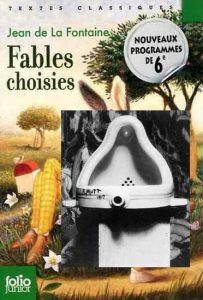 –Fable: What resources are available for inquiry and expression in the conditions after Nietzsche, the history of an error, after the simultaneous withdrawal of the true world and the apparent world along with it? The time is noon (the shortest shadow). What remains is fable, Nietzsche said. What are the possibilities of fable as genre? Duchamp improvised one approach, perhaps not even yet fully appreciated. His Readymades are fables, albeit weak (faible) fables, in that they provide the illustrations only (the emblems, impresas). He intimated his variation on the mode with his most notorious instance, whose title “Fountain” translates “La Fontaine,” antonomasia between common and proper noun, evoking the name of the author of many fables in the common “fountain,” itself a euphemistic title for a urinal. Ulmer’s collage of the urinal with a cover of La Fontaine’s book make the joke explicit. Duchamp’s commitment to the punning bachelor machine logic central to modernism is well known. He acknowledged his attendance at a performance of a stage adaptation of Raymond Roussel’s 1910 novel Impressions of Africa as a turning point in his career (Roussel’s method of composition used generative puns). It has been suggested that some of the Readymades at least are comments on dreams described in Freud’s Interpretation of Dreams, hence that they use rebus methods (visualizations evoking words). Freud noted, for example, that many dreams are triggered when sleepers experience the need to urinate (the dream allows sleep to continue briefly). The text of the fabled fountain is provided by its history, being as it is the most influential (if not the “best”) art work of the twentieth century, including its status as a prank, and all the manipulations Duchamp performed to put the image of La Fontaine into circulation, recorded in Thierry De Duve’s Kant After Duchamp. What is the moral of the readymade fable?
–Fable: What resources are available for inquiry and expression in the conditions after Nietzsche, the history of an error, after the simultaneous withdrawal of the true world and the apparent world along with it? The time is noon (the shortest shadow). What remains is fable, Nietzsche said. What are the possibilities of fable as genre? Duchamp improvised one approach, perhaps not even yet fully appreciated. His Readymades are fables, albeit weak (faible) fables, in that they provide the illustrations only (the emblems, impresas). He intimated his variation on the mode with his most notorious instance, whose title “Fountain” translates “La Fontaine,” antonomasia between common and proper noun, evoking the name of the author of many fables in the common “fountain,” itself a euphemistic title for a urinal. Ulmer’s collage of the urinal with a cover of La Fontaine’s book make the joke explicit. Duchamp’s commitment to the punning bachelor machine logic central to modernism is well known. He acknowledged his attendance at a performance of a stage adaptation of Raymond Roussel’s 1910 novel Impressions of Africa as a turning point in his career (Roussel’s method of composition used generative puns). It has been suggested that some of the Readymades at least are comments on dreams described in Freud’s Interpretation of Dreams, hence that they use rebus methods (visualizations evoking words). Freud noted, for example, that many dreams are triggered when sleepers experience the need to urinate (the dream allows sleep to continue briefly). The text of the fabled fountain is provided by its history, being as it is the most influential (if not the “best”) art work of the twentieth century, including its status as a prank, and all the manipulations Duchamp performed to put the image of La Fontaine into circulation, recorded in Thierry De Duve’s Kant After Duchamp. What is the moral of the readymade fable?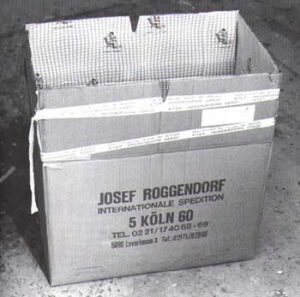 –Martin Kippenberger, “Rameau’s Nephew,” 1988
–Martin Kippenberger, “Rameau’s Nephew,” 1988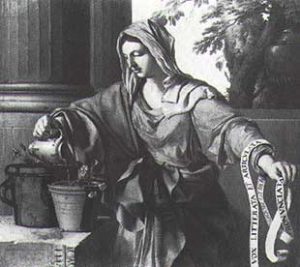 This pictorial tradition can be traced back to an engraving by Marc Antonio. It shows an almost naked woman of Giorgionesque type watering a flower. This enigmatic motif can be explained with the help of the literary tradition. It is a symbol of “Grammatica.” As the plant grows through watering so the young mind is formed through the study of grammar. In late antiquity grammar became the foundation of the liberal arts.
This pictorial tradition can be traced back to an engraving by Marc Antonio. It shows an almost naked woman of Giorgionesque type watering a flower. This enigmatic motif can be explained with the help of the literary tradition. It is a symbol of “Grammatica.” As the plant grows through watering so the young mind is formed through the study of grammar. In late antiquity grammar became the foundation of the liberal arts.